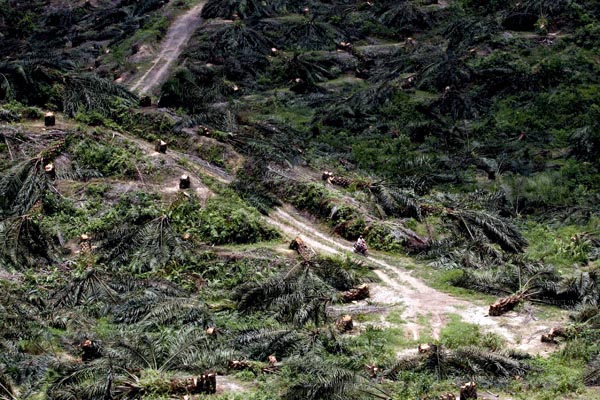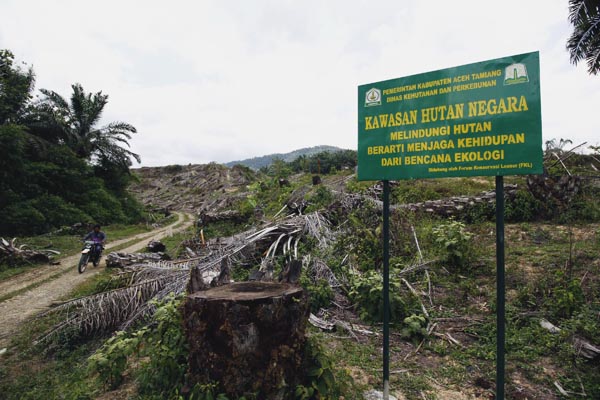
Felled oil palm trees in Aceh Tamiang. Photo: Junaidi Hanafiah
A joint effort to eradicate illegal oil palm in an area of Indonesia’s Aceh province that was devastated by flash flooding in 2006 has dismantled 3,000 hectares worth of plantations and counting.
The plantations lie within the protected Leuser Ecosystem (KEL), the last place on earth where the Sumatran rhino, elephant, tiger and orangutan coexist in the wild.
“This is being done to protect the people of Aceh Tamiang from ecological disaster,” said Rudi Putra, head of HAkA, a local NGO.
In 2006, parts of central and eastern Aceh were hit by a wave of floods and landslides so violent that it was likened to a “second tsunami.” Aceh Tamiang was at the center of the catastrophe, in large part because upstream deforestation had eroded crucial ecosystem services that normally mitigate fallout from heavy rain. Tens of thousands of the regency’s citizens were displaced.
“This region is expected to control water and improve the people’s economy,” said Rudi, who won the prestigious Goldman Prize in 2014. “In fact, the regent of Aceh Tamiang has issued a decree for the eradication of these plantations.”

A government sign in Aceh Tamiang reads, “Protecting forest means guarding against ecological disaster.” The regency was devastated by floods and landslides in 2006. Photo: Junaidi Hanafiah
The effort, a partnership involving the local and provincial governments and police forces, NGOs and the people of Aceh Tamiang, kicked off in September last year.
Twenty-six companies running illegal plantations have been identified, with one person sentenced to six months behind bars and a Rp10 million fine and another person named a suspect. “The rest gave up their land voluntarily,” Rudi said.
The destruction of Aceh Tamiang’s forests, he added, began in the 1970s with timber concessions (HPH) upstream and downstream of the Tamiang River. The 1980s saw land begin to be converted into oil palm.
That peaked in the 2000s, when multitudes of plantations appeared in areas designated not as “land for other uses” (APL) but as “protected forest,” in which oil palm is illegal.
“More than 10,000 hectares of forest upstream has been severely damaged and four or five thousand hectares have been converted into illegal oil palm,” Rudi said.
The head of Aceh’s Forestry Office, Husaini Syamaun, called the dismantling of the plantations an appropriate measure. “Protected forests are important to the lives of people who live around them,” he said. “If the forest is damaged, the people will feel the impact, like what happened with the floods in 2006.”
“This is incredible work,” he added. “We should welcome this kind of awareness.”
Produced in English by Philip Jacobson.
Citations:
- Junaidi Hanafiah. “Pemusnahan Tiga Ribu Hektar Kebun Sawit yang Masuk KEL di Aceh Tamiang Terus Dilakukan.” Mongabay-Indonesia. 1 April 2015.